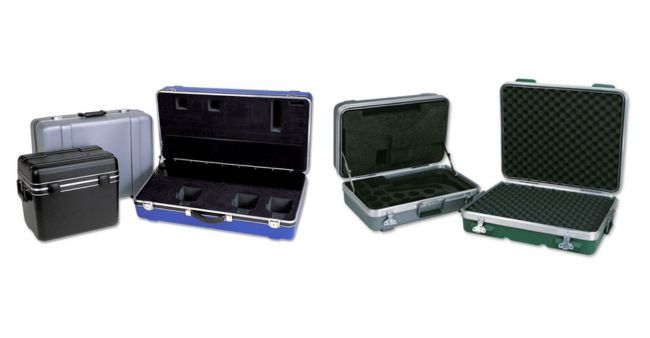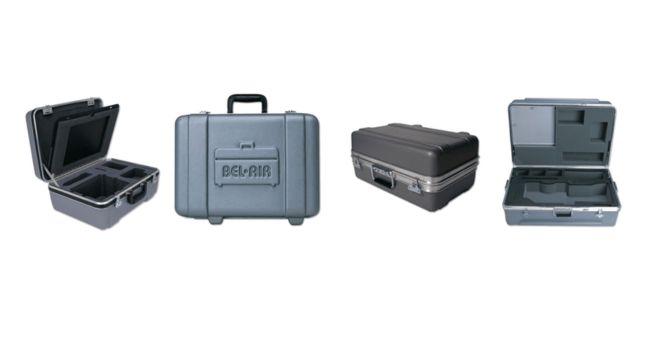Contact Us (866) 235-2472 info@bel-air-cases.com
Hard Plastic Shipping Cases: Exceeding ATA Standards
In the last 50 years or so, we’ve built thousands of hard plastic shipping cases. Our cases are meant to handle the rigors of transport with ease whether they are bouncing along in a Boeing C-17 on route to Afghanistan or tossed around in a container ship during stormy weather or just used for a cross-country flight on a domestic carrier.
Our hard plastic shipping cases are built using some of the most durable materials on earth. Additionally, we design the cases to meet ATA guidelines as well as many MIL specifications.
What Are These ATA Standards?
You’ll often see companies sell hard plastic shipping cases (including our own) built to ATA 300 Category 1 specs or they might simply call their products ATA cases. But what does this mean and why is this important?
ATA stands for Air Transport Association, and this group was formed in 1936 to support the air transportation industry. It is now called Airlines for America and includes Alaska Airlines, American Airlines, Atlas Air, FedEx, Hawaiian Airlines, JetBlue, Southwest, United and UPS.
In 1960, when this group was still known as the ATA, they published a set of standards or specifications for shipping cases. Cases that meet these standards, which are known as ATA Specification 300 standards, are able to handle the rigors of air travel without damaging the contents of the cases.
When you buy an ATA case, this does not mean that the case has been approved by this group. It simply means that we have studied the standards and built cases that meet or exceed these standards. For any delicate or expensive item, we highly recommend that you find cases that meet ATA standards, such as our own.
When it comes to identifying Category 1 cases, these are reusable cases that are built to handle a minimum of 100 round trips via air travel. There are also Category II containers, but these are built to handle only a minimum of 10 round-trips.
These standards also identify the types of materials that should be used to build shipping cases, as well as the configuration and size, the interior cushioning, closure fasteners and hardware, and even the handles.
Materials
For Category I cases, materials such as metal, plastic, fiberglass and plywood are acceptable. We use high-density polyethylene (HDPE) for our hard plastic shipping cases, which has many benefits over other ATA-approved materials.
Our plastic is very lightweight, which makes it easier for our clients to transport or carry their cases, as well as possibly lessening shipping costs. HDPE also is a highly affordable material, which lowers overall costs for our clients. HDPE is durable and resistant to moisture and water as well as chemicals and solvents. Basically, if your case is left standing on a tarmac in a puddle of jet fuel as the rain beats down on it, whatever is inside will remain safe and dry.
In order to comply with ATA standards, a shipping case must be able to withstand temperatures that range from -40°F up to 130°F. Our hard plastic shipping cases go well beyond this standard and can handle temperatures between -80°F up to 180°F. So drag your case through Death Valley in the middle of August or send it on an expedition to Antarctica and rest assured your case can handle the extremes.
Design
ATA standards also include a section regarding the design, configuration and size of a shipping case. Of particular importance, the ATA standards also discuss the type of interior cushioning that must be present.
The interior cushioning must be able to protect your equipment from vibrations or shock. Additionally, the interior cushioning must be crafted from materials that are durable, resilient, mold-resistant and these materials cannot produce dust.
At Bel-Air Cases, we take a great deal of pride in our foam interiors. We study your equipment carefully to create custom foam interiors that truly protect your items from damage. If a case is dropped, jostled or bumped, we ensure that the impact is absorbed by the case and the foam and not your products. We also can add features such as shock mounts, panel mounts, interior doors and so forth to ensure that every inch of your equipment fits perfectly and is perfectly protected.
The ATA standards also specify the types of closure fasteners, hardware and handles that should be placed on a case. For instance, all of these items should be flush or recessed so that they don’t protrude beyond the case edges. This ensures that handles and latches and fasteners aren’t damaged as they are being jostled about in a cargo hold or along a conveyor belt. If handles cannot be recessed or flush, guarded surface-mounted handles can be used.
We have a wide variety of handles, hinges, latches and feet and if you don’t see exactly what you want or need, we can probably track it down. With Bel-Air Cases, it’s all about choice and creating custom cases that fully meet your needs.
The ATA standards even discuss the color of the cases, and while they recommend that all Category I cases be white, this is not a requirement for compliance and we offer many different color options for our hard plastic shipping cases. Our standard colors are black and silver, but we also have an assortment of optional stock colors, including white, yellow, orange, red, olive, green and blue. We also can add decals, molded in logos and even engraved plates if requested.
No matter what color you select, your Bel-Air case is built to withstand whatever the transportation industry throws at it – literally. In addition to shipping cases, we also create custom expo cases as well as light-duty, medium-duty and heavy-duty carrying cases.
Come & Take A Tour
All of our hard plastic shipping cases as well as our carrying cases and expo cases are designed and built at our Ontario, California, facility. If you’re ever in the area, feel free to stop by and we’ll give you a tour.
How To Order
If you need hard plastic shipping cases, we can provide you with just about any size of case you might need as well as custom foam interiors for each case. To get started, just click on the Contact Us tab at the top of our homepage and fill our quick contact form. A friendly customer service rep will be in touch quickly to start discussing your project.



